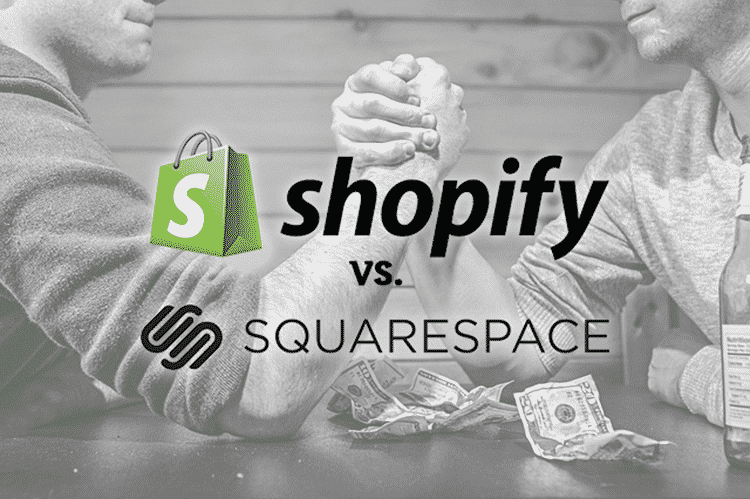The Squarespace platform is not new but is more known for blogging or portfolio site creation, and e-commerce store creation capabilities are recent. As such, the e-commerce features presently offered by Squarespace are limited, so if what you have on hand is a large e-commerce operation, you may have to look at more mature platform.
Key Pros of Shopify:
Shopify has a selection of ‘themes’ in its Theme Store, these can be easily installed onto your website to give it a graceful look with lots of functionality. Every website made using Shopify does not show any trace of the platform. In this sense, Shopify and Squarespace both are white-label systems.
If you wish to customise these themes beyond the simple changes, then you can make more you need to have a good understanding of CSS and HTML and Liquid. The liquid is Shopify’s proprietary language for creating themes for their platform. It allows you to manipulate the theme, creating a custom look and feel that is unique to your brand. You can have a freelance web designer work for you on these changes.
Shopify offers the option to sell both online and in a physical shops. Using Shopify’s POS software, you can easily link everything between your online and actual shops. Shopify has released card reader, barcode scanner, receipt printer and cash drawer. Regarding software, Shopify has an official iPad app to accept payments from Visa, MasterCard, and American Express.
Key Pros of Squarespace:
Squarespace provides you with templates that command your attention. Their templates are clean, simple but professional. As there are multiple themes, the challenge with Squarespace is to pick a single theme out of the many options that you will like.
While Shopify’s themes are also aesthetically great, Squarespace’s main USP is their expertly designed templates. Theme customisation isn’t new, and Squarespace is not doing anything new here. Their Style Editor makes it exceptionally easy for a non-technical person to customize their website design without having to type any code. There is a built-in CSS editor so you can maximise the customisation of your website if you understand the code. Someone like a freelance web developer can do this task for you.
Comparison of these two platforms:
Basic e-commerce functionality: While both the platforms offer adequate basic features and functionalities regarding creating a good store, Shopify is ahead in the game as it is an old e-commerce platform compared to Squarespace e-commerce platform and specifically developed for shopping websites.
Inventory management: While the Squarespace starter plan is much lower than Shopify’s. Squarespace allows you to sell just one product with this plan as compared to Shopify’s allowance of 25 products. The higher plans in both platforms allow you to sell an unlimited number of products.
Shipping charges: This is one of the basic features of an e-commerce platform, and as would be expected, both Shopify and Squarespace handle this quite efficiently.
Payment gateway options: Shopify offers more than 70 different payment gateways, and Squarespace supports only Stripe gateway. The Stripe gateway is more convenient than many other payment methods, but it allows payments from a very small number of countries.
Themes and Templates: Shopify has close to 100 free themes as compared to 25+ themes by Squarespace. Though the number of themes is less in Squarespace, they are all highly stylish and modern. Both platforms keep adding new Themes and templates.
Multi-lingual capabilities: There isn’t a fully-featured multi-lingual capability available at either of the platforms. Shopify has multi-lingual capability offered on the checkout pages. Shopify has an advantage of the availability of third-party tools with which you can implement site-wide multi-lingual capabilities.
SEO: Both platforms offer good SEO capabilities. However, the Shopify SEO features are not only superior to those of Squarespace but also the highest amongst all major e-commerce platforms. If while coding the SEO related design is considered, the platform obviously becomes more effective for search engines.
Blogging: Both platforms offer integrated blogging functionality that happens to be a very useful for e-commerce stores. A blog on your online store website always adds a lot of value to your store and attract and retain customers making this functionality very important.
Coupons and Discounts: Shopify does not allow this on the starter plan but only on the higher ones. Squarespace allows promo codes on all the plans. Coupons and offers make an important part of an online store when the stores starts growing.
Apps and Add-ons: Shopify, with well 100+ own as well as third-party apps, add-ons, plugins, widgets, etc. is at an advantage. Squarespace has support for only a handful of apps, mainly via Google Apps integration.
Customisation: Both platforms offer an easy mode with which you can customize the basic elements of your online store. You can hire some freelance gigs doing this task for you.
Setup fees: Neither Shopify not Squarespace charge any setup fees. Both offer 14-day free trials.
Squarespace and Shopify are quite easy to use e-commerce platforms, Shopify has a lot of features and power as compared to Squarespace that presently offers a fairly limited set of e-commerce features.
What about Support?
Shopify and Squarespace both offer you very good support. Shopify gives you more ways to get in touch with them when you need help. They can be contacted 24 X 7 through 3 main support channels: phone, email or live chat.
As Shopify’s payment plans are at higher price points when compared to Squarespace’s plans and as a result, they also provide more service options and prompt service. Shopify also offers you access to a group of qualified experts whom you can hire if you need to customise your store even further. It is possible to take assistance from a freelance designer and make the modifications.
Though Shopify seems to have advantages over Squarespace for e-commerce platform as on date, you can’t ignore a strong player like Squarespace. It is developing well and you can select the right platform based on your needs like exact matching template and not just historical data.




